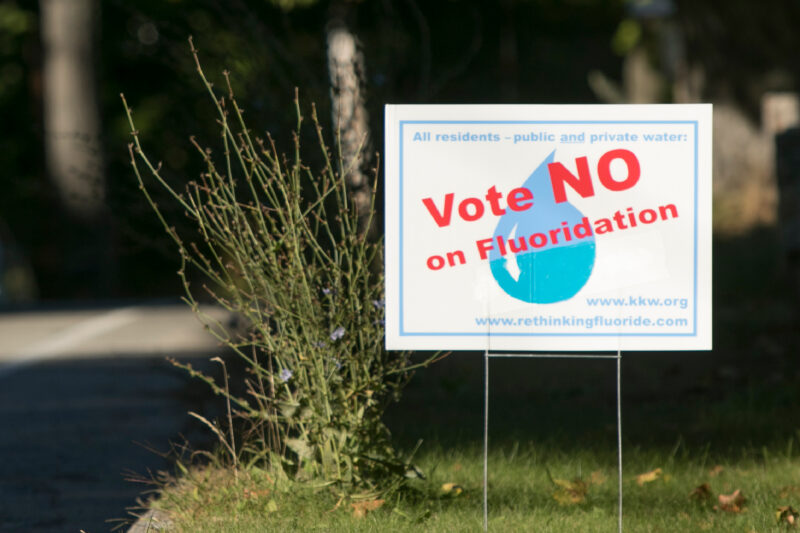As Bans Spread, Fluoride in Drinking Water Divides Communities Across the US

MONROE, N.C. — Regina Barrett, a 69-year-old retiree who lives in this small North Carolina city southeast of Charlotte, has not been happy with her tap water for a while.
“Our water has been cloudy and bubbly and looks milky,” said Barrett, who blames fluoride, a mineral that communities across the nation have for decades added to the water supply to help prevent cavities and improve dental health.
“I don’t want fluoride in my nothing!” said Barrett, echoing a growing number of people who not only doubt the mineral’s effectiveness but also believe it may be harmful despite decades of data pointing to public health and economic benefits.
In February, the Board of County Commissioners in Union County, whose seat is Monroe, voted 3-2 to stop adding fluoride to drinking water at the Yadkin River Water Treatment Plant, the only water source wholly owned and operated by the county. But the decision came after heated discussions among residents and county officials.
“My children had the blessing of growing up with fluoride in their water and … they have very little dental issues,” said Commissioner Richard Helms ahead of the vote. A fellow commissioner saw it differently: “Let’s stop putting something in the water that’s meant to treat us, and give people the freedom to choose,” said David Williams.
Barrett’s water comes from the city of Monroe, not the Yadkin facility. So, for now, she will continue to drink water enhanced with fluoride. “I’m suspicious as to why they add that to our water,” she told KFF Health News.
It is a scenario playing out nationwide. From Oregon to Pennsylvania, hundreds of communities have in recent years either stopped adding fluoride to their water supplies or voted to prevent its addition. Supporters of such bans argue that people should be given the freedom of choice. The broad availability of over-the-counter dental products containing the mineral makes it no longer necessary to add to public water supplies, they say. The Centers for Disease Control and Prevention says that while store-bought products reduce tooth decay, the greatest protection comes when they are used in combination with water fluoridation.
The outcome of an ongoing federal case in California could force the Environmental Protection Agency to create a rule regulating or banning the use of fluoride in drinking water nationwide. In the meantime, the trend is raising alarm bells for public health researchers who worry that, much like vaccines, fluoride may have become a victim of its own success.
The CDC maintains that community water fluoridation is not only safe and effective but also yields significant cost savings in dental treatment. Public health officials say removing fluoride could be particularly harmful to low-income families — for whom drinking water may be the only source of preventive dental care.
“If you have to go out and get care on your own, it’s a whole different ballgame,” said Myron Allukian Jr., a dentist and past president of the American Public Health Association. Millions of people have lived with fluoridated water for years, “and we’ve had no major health problems,” he said. “It’s much easier to prevent a disease than to treat it.”
According to the anti-fluoride group Fluoride Action Network, since 2010, over 240 communities around the world have removed fluoride from their drinking water or decided not to add it.
One needs only to look to Union County to see just how intense discussions can be. Usually when the commissioners meet on the first floor of the Government Center in downtown Monroe, there are more vacant seats than attendees. But sessions about the prohibition of fluoride in public water supplies were packed, and residents who signed up to speak were divided.
One person who came to the microphone on Feb. 5 compared water fluoridation to a seat belt. It does not “prevent the car crash, but it limits the harm done,” he said. Another argued that there is no proof fluoride is safe or effective. “It’s a significant potential milestone to reverse 60-plus years of poisoning the public,” he said, using an unproven claim often made by opponents of fluoridation.
Fluoride opponents claim the mineral is responsible for everything from acne to high blood pressure and thyroid dysfunction to bone cancer.
The National Institutes of Health acknowledges that, when ingested in extremely large amounts, fluoride from dental products or dietary supplements can cause nausea, vomiting, abdominal pain, diarrhea, bone pain, and even death in extremely rare cases.
Infants and children who receive too much fluoride can develop discoloration or small dents in their teeth. In adults, consumption of excessive fluoride for extended periods can lead to skeletal fluorosis, a very rare condition that causes joint pain and stiffness, weak bones, muscle loss, and nerve problems.
However, the recommended dosage in drinking water has always been small. In 2015, the Department of Health and Human Services lowered the optimal fluoride concentration from 1.2 milligrams per liter to 0.7 mg/L.
Juneau, Alaska, voted to remove fluoride from its drinking water in 2007. A study published in the journal BMC Oral Health in 2018 compared the dental records of children and adolescents who received dental care for decaying teeth four years before and five years after the city stopped adding fluoride to the water. Cavity-related procedures and treatment costs were significantly higher in the latter group, the study found.
Portland, Oregon, is the largest city in the nation that has consistently refused to fluoridate its drinking water. Voters have repeatedly rejected measures to add it, first in 1956 and the latest time in 2013.
Despite the strong recommendation of local doctors and dentists, voters in Wichita, Kansas, have rejected adding fluoride to the water several times, most recently in 2012.
The Brushy Creek Municipal Utility District in Williamson County, Texas, had been adding fluoride to its water system since 2007 but ended the practice in December.
In 2016, Collier County, Florida, commissioners opted not to remove fluoride from the water system. But they unanimously reversed that decision following a 2023 Health Freedom Bill of Rights county ordinance in response to covid-19 “to safeguard the healthcare rights and freedoms of Collier County residents.”
The State College Borough Water Authority in Pennsylvania stopped adding fluoride to the water of its 75,000 customers in March 2023. Officials used claims often cited by fluoride opponents, such as potential environmental contamination, concerns about medical freedom, and possible adverse health effects, like the potential for the appearance of faint white lines on the teeth and lowered IQ for babies.
A study published in JAMA Pediatrics in 2019, conducted in six Canadian cities, associated fluoride exposure during pregnancy with lower IQ scores in children. But the study was based on self-reporting and has been criticized for its perceived methodological shortcomings.
In 2016, several consumer advocacy groups, including the Fluoride Action Network, Food & Water Watch, and Moms Against Fluoridation, petitioned the EPA to end water fluoridation under the Toxic Substances Control Act, alleging that significant research showed fluoride was neurotoxic at the doses now used. The same group filed a federal lawsuit against the EPA the following year, after the agency denied their citizen petition.
During a 10-day bench trial in San Francisco that concluded in mid-February, the two sides debated the risks and areas of uncertainty. If Senior U.S. District Judge Edward Chen determines water fluoridation presents an “unreasonable risk” to human health, the EPA will be forced to create a rule regulating or banning water fluoridation in the U.S. A decision is expected soon.
For the time being, decisions about whether to fluoridate community water systems are still made primarily at the local level, which Barrett hopes will change.
“Of all things, they want our teeth healthy when basic needs of housing and food are lacking.”








